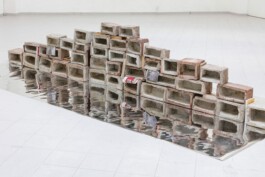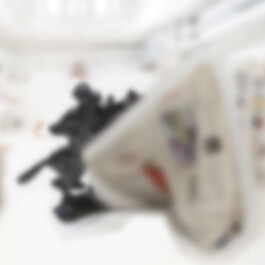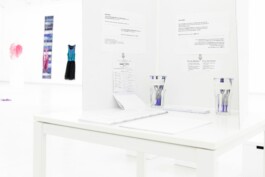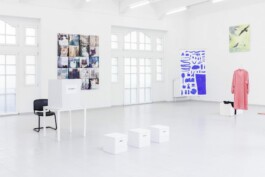In Conversation with
Renata Kaminska
Renata Kaminska, Artist Talk
Tanja Heuchele: Can you describe your milestones briefly?
Renata Kaminska: I was born in socialist Poland, in the Eastern Borderlands, studied at Art Akademie in Lublin / PL, Zürich / CH and Leipzig / D.
TH: Your life without art would be…
RK: My story with art started when I was in junior high, where I passed the preliminary exam for the Bernardo Morando art school in Zamosc. I took exams in two different high schools simultaneously: an art school and a medical school. All the preliminary exams were at the same time, so it was impossible to take them one by one. I loved art, but neurology was my passion, too. Unfortunately, during my medical exams, I noticed that I can’t stand the sight of open wounds, because I fainted. So I’ll never know what my life without art would have been.
TH: What material inspires you the most? And which materials are you working with the most at the moment?
RK: I’m predominantly working with everyday materials across urban landscapes. It’s all about love in the urban jungle. Concrete romantic affair.
The Artist, Renata Kaminska
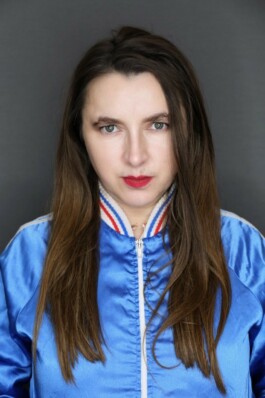
Renata Kaminska, Artist Talk
TH: Are there also materials that you would never use again?
RK: Strobe. I pass out right away.
TH: What literature did you study for preparing your art piece(s)?
RK: I have been reading since I was five, and I’ve never stopped. So this spectrum is quite extensive and multilingual, and I make use of its whole scope.
TH: What is your work about? What is your intention with it? What should it evoke in the viewer’s emotion?
RK: My work in sculpture, installation, and video examines the marks left by the individual, society, and shifting power structures on public space and how they become part of shared memory. The place of these marks within collective memory depends on the willingness of political discourse to maintain them. Only through responsibility do you experience emotions.
Renata Kaminska, Exhibition View, 2021
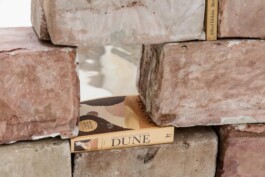
Renata Kaminska, Artist Talk
TH: What does Rosa Luxemburg mean to you? When did the journey with Who’s afraid of_Rosa begin for you, and what keeps you involved?
RK: In pursuit of this utopian ideal, I find inspiration in figures throughout history who share my motivation. Notable among them is Rosa Luxemburg, the prolific revolutionary democratic socialist and martyr. Born in the same city as Luxemburg in Poland and, like her, spending most of my life in Berlin, I’m able to access the shifting shape of Luxemburg’s place in history. Memorialized and celebrated in Berlin and Germany, her memory is simultaneously being erased across Poland. Drawing on this tension, I reflect on different protest movements of the last century, seeking a response to unfulfilled demands for equality. She did this to draw attention to the ubiquity of calls for universal rights and freedoms, which have continued into the 21st century and which still resound today. So it’s not over.
TH: How is the collective Who’s afraid of_Rosa organized? So far, I’ve only met female Rosa’s… can men also be part of it?
RK: For me, our collective is like a hive. We have more queens only as an exception. So, emmm … no.
TH: The subline of the exhibition is public space – private space – political space. What space do you (not) feel comfortable in? Where would you like to make a difference? What is your perception of space? Is it even the case that the above-mentioned spaces do not exist without each other?
RK: “Who owns the public space, and how much of it is mine?” For me, the public’s access to space is a litmus test for the social freedom of the respective society. To return to the idea of leaving marks on public space from a previous question: as a native of Poland in my chosen city of Berlin, in my work, I negotiate what it means for those traces to occupy public space and how they are transformed across different social, cultural, political, economic, and linguistic contexts. Calling for the discussion and disruption of capitalism-fueled globalized Western society.
Renata Kaminska, Exhibition View, 2021
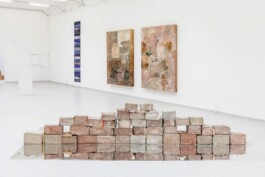
Renata Kaminska, Artist Talk
TH: How do you react to people who are not familiar with art, and how do you think they can be made to understand better?
RK: Through responsibility.
I include them in the experience.
I allow space for questions, etc.
TH: What do you enjoy about your life as an artist?
RK: Combining all the areas that interest me. And there are many….
TH: What is great art for you?
RK: When it’s unique.
TH: What about your next projects, exhibitions? Where can you be seen next?
RK: 2022
Kommunale Galerie / Speicher, Berlin, Germany
FAMA, São Paulo, Brazil
Kunsthalle, Foundation stArt, Warsaw, Poland
Haus ON, Athens, Greece
Fondazione Giorgio Cini, Isola San Maggiore, Italy
Siehe auch
More Interviews
